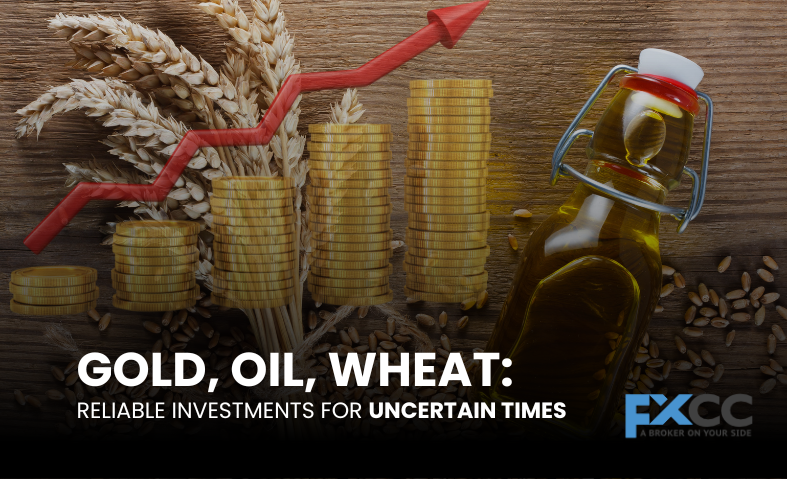In today’s volatile financial markets, investors are increasingly turning to time-tested commodities like gold, oil, and wheat. These assets offer stability and growth potential that many modern investments lack. Unlike stocks or cryptocurrencies that can swing wildly based on market sentiment, these commodities have intrinsic value tied to real-world demand.
Why Commodities Matter Now
Several factors are driving renewed interest in these traditional assets:
- Persistent inflation eroding purchasing power
- Geopolitical tensions disrupting supply chains
- Growing population, increasing demand for basic resources
- Climate change impacting agricultural production
Let’s examine why gold, oil, and wheat deserve consideration in today’s investment portfolios.

Gold: The Ultimate Store of Value
Gold has retained its value over millennia, proving to be a trusted means of preserving wealth through numerous financial ups and downs.
Key Benefits of Gold Investment
- Inflation Hedge: Gold typically rises when currency values fall, protecting against loss of purchasing power.
- Safe Haven Asset: During market turmoil, investors flock to gold, driving prices higher.
- Portfolio Diversifier: Gold often moves independently of stocks and bonds, reducing overall portfolio risk.
Ways to Invest in Gold
- Physical gold (bars, coins)
- Gold ETFs (like GLD)
- Gold mining stocks
- Gold futures contracts
Recent trends show central banks aggressively accumulating gold reserves, signaling strong institutional confidence in its long-term value.
Oil: The Indispensable Energy Source
Even with the rise of renewable energy sources, oil continues to be a crucial driver of economic activity worldwide. Its price movements create significant investment opportunities.
Why Oil Remains Relevant
- Inelastic Demand: The world still consumes about 100 million barrels daily regardless of price fluctuations.
- Geopolitical Premium: Conflicts in oil-producing regions can rapidly drive prices higher.
- Economic Recovery Play: Oil demand surges when economies rebound from downturns.
Oil Investment Options
- Energy sector ETFs
- Oil company stocks
- Crude oil futures
- Master limited partnerships (MLPs)
Investors should monitor OPEC decisions, inventory reports, and global economic growth projections when trading oil.
Wheat: The Essential Agricultural Commodity
As a staple food for billions, wheat represents both a necessity and an investment opportunity.
Factors Driving Wheat’s Investment Potential
- Growing Population: More people means steadily increasing demand.
- Climate Vulnerability: Droughts and extreme weather frequently disrupt production.
- Geopolitical Risks: Major producers like Russia and Ukraine can significantly impact global supply.
How to Gain Exposure to Wheat
- Agricultural commodity ETFs
- Wheat futures contracts
- Farm equipment and processing company stocks
The Ukraine conflict demonstrated how quickly wheat prices can spike when supplies are threatened, creating potential profit opportunities for alert investors.
Building a Commodity Investment Strategy
For investors considering commodities, here’s a sensible approach:
- Determine Your Objectives: Decide whether you seek inflation protection, speculation, or portfolio diversification.
- Choose Appropriate Vehicles: Select investment methods matching your risk tolerance and expertise.
- Allocate Wisely: Most experts recommend keeping commodity exposure below 20% of total portfolio value.
- Stay Informed: Track relevant economic indicators, weather patterns, and geopolitical developments.
Risks to Consider
Although investing in commodities can be beneficial, it’s important to recognize the potential risks involved:
- Price volatility can be extreme
- Futures trading requires specialized knowledge
- Storage costs for physical commodities
- Potential for long periods of underperformance

Gold, oil, and wheat represent three distinct but equally valuable components of a well-rounded investment strategy. In an era of economic uncertainty, these commodities provide tangible assets that have stood the test of time.
Gold preserves wealth, oil offers growth potential tied to global economic activity, and wheat benefits from fundamental food demand. By incorporating some combination of these assets into their portfolios, investors can achieve better diversification and protection against various market risks.
As with any investment, success with commodities requires research, patience, and disciplined risk management. Those who take the time to understand these markets may find they offer rewarding opportunities unavailable in more conventional investments.


